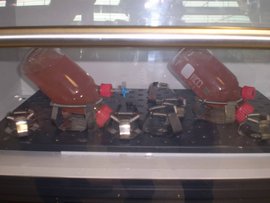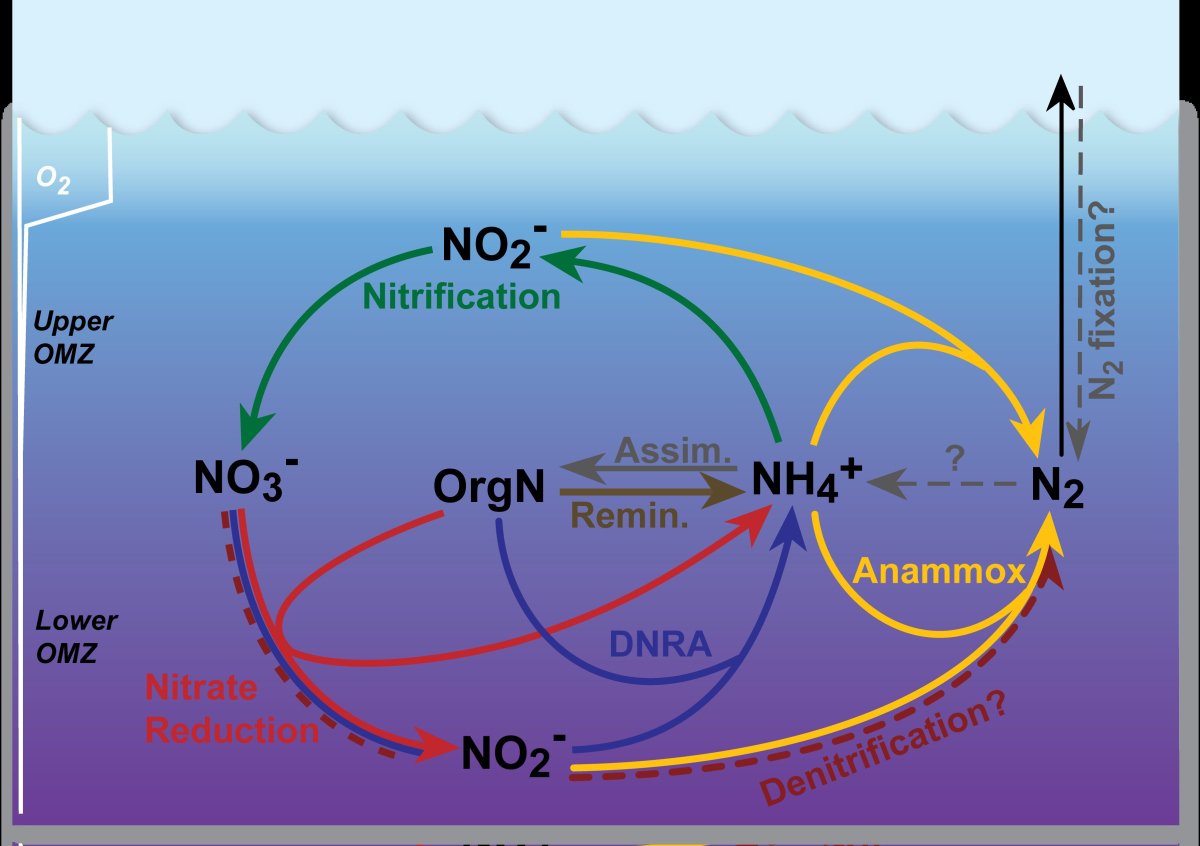Page path:
- Departments
- Department of Biogeochemistry
- Biogeochemistry Group
- Projects
- The Role of Anammox for the Oceanic Loss of Nutrient Nitrogen
The Role of Anammox for the Oceanic Loss of Nutrient Nitrogen
Globally, 30-50% of oceanic N-loss occurs in oxygen minimum zone (OMZ) waters. For decades, oceanic N-loss has been attributed entirely to heterotrophic denitrification. We showed instead, that anammox is the main N-loss process in the Namibian and Peruvian OMZs (Kuypers et al., 2005; Hamersley et al., 2007). The occurrence and regulation of anammox, as well as its interactions with other N-cycling processes, are being investigated in the field as well as in the laboratory.
Interactions of Anammox with other N-Cycling Processes
Anammox (yellow) has been found to be the predominant nitrogen loss pathway in Peruvian, Arabian Sea and Namibian OMZs, with the highest rates usually found towards the coast, but remaining detectable as much as >600 km offshore. Anammox is directly coupled to nitrate reduction (red) and ammonia oxidation (first step of nitrification) (green) for sources of nitrite. The ammonium required by anammox originated from DNRA (blue) and remineralization of organic matter via nitrate reduction and likely microaerobic or other suboxic respiration. Coupling with oxidative processes (upper oval) likely decreases towards the lower OMZ. Denitrification (dark red, dashed), was previously the only known N-loss pathway. Nitrogen fixation (grey dashed) might be spatially coupled to nitrogen loss near the OMZ but has yet to be assessed in situ.
Because of such couplings, a straightforward relationship between N-loss and any environmental parameter would be unlikely. Conventionally, nitrite has been used as an indicator of active N-loss (denitrification) in oceanic OMZs, such as the prominent secondary nitrite maximum in the open-ocean northeastern Arabian Sea. However, at the end of SW Monsoon 2007, we detected >2 orders of magnitude greater N-loss over the productive Omani Shelf, a region without obvious nitrite accumulation, than in the open-ocean OMZ. Our results revealed that nitrite accumulated in the open-ocean OMZ due to an overproduction via primarily nitrate reduction. There was hardly any detectable consumption via either denitrification or anammox, but only some indication of nitrite oxidation and N2O production. Hence, nitrite seemed to be a poor indicator for active N-loss in the Arabian Sea, as well as in the Peruvian and Namibian OMZs. Instead, our data suggested an important role of organic matter, the remineralization of which was an essential ammonium source for anammox. This interpretation would be consistent with the higher rates detected over Omani Shelf and in the other OMZs with more productive overlying waters.
Stable Nitrogen Isotope Fractionation due to Anammox
As heterotrophic denitrification has been the only known N-loss pathway for decades, its stable isotopic effect (~25‰) has been the only explanation for the strong 15N enrichment in residual NOx- in oceanic OMZs – a signal used to estimate N-loss in past and present oceanic N-budgets. However, the recently reported wide occurrence of anammox as an N-loss pathway in various OMZs strongly questions such isotope-based N-budget estimates. Experiments with a highly enriched (>98%) anammox culture (Kuenenia stuttgartiensis), will help us to characterize the nitrogen isotope effects by anammox.

Anammox culture experiments (photo by S. Contreras Quintana)
